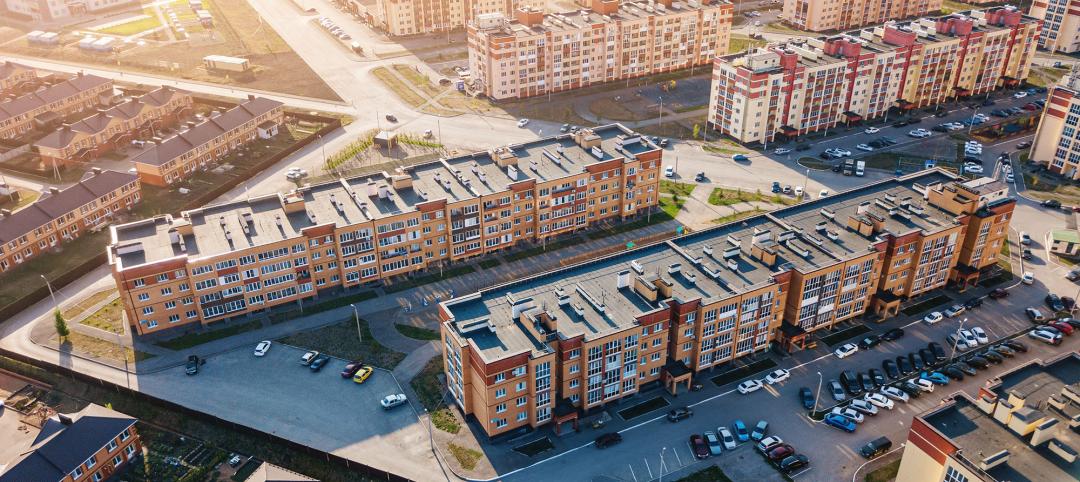Seven years removed from the beginning of the most severe housing market crash since the Great Depression, the U.S. single-family residential sector is finally starting to snap out of its long period of malaise. Home prices, new-home sales, existing-home sales, and housing starts have all trended higher during the past 12-18 months, and while the market remains significantly depressed relative to 2005-06 output, it’s safe to say the single-family housing sector is in a much healthier state.
During the depths of the recession, multifamily construction remained one of the few relatively bright spots of the nation’s residential building sector, driven largely by pent-up demand for apartments and other rental units, such as student and senior housing. But as the economy recovers and homeownership becomes a realistic option for more consumers, the question becomes: Does this spell the end of the multifamily sector’s hot streak?
Not anytime soon, according to FMI’s Construction Outlook Report for First Quarter 2013, which predicts a 31% YOY increase in multifamily construction spending in 2013 and another 27% in 2014 (following 47% growth in 2012). The sector is expected to reach its housing boom peak ($54 billion in annual construction spending) by 2017—although annual percent growth will taper off over the next four years.
Real estate investment services firm Marcus & Millichap is forecasting long-term demand for rental housing to remain strong across most U.S. metro markets. According to its 2013 Apartment Outlook, the recent boom in apartment construction—85,000 units completed in 2012 and an estimated 150,000 units to come online this year, up from just 40,000 in 2011—isn’t enough to meet the pent-up demand for rentals in most markets.
TOP MULTIFAMILY ARCHITECTURE FIRMS
2012 Multifamily Revenue ($)1 IBI Group $42,729,4362 Niles Bolton Associates $22,446,8213 Perkins Eastman $17,400,0004 WDG Architecture $17,233,0005 Solomon Cordwell Buenz $16,000,0006 RTKL Associates $12,992,0007 Perkins+Will $10,783,6198 Skidmore, Owings & Merrill $10,179,0009 HOK $7,730,00010 VOA Associates $6,902,030
TOP MULTIFAMILY ENGINEERING FIRMS
2012 Multifamily Revenue ($)1 STV $42,284,0002 URS Corp. $42,072,0703 AECOM Technology Corp. $39,580,0004 Parsons Brinckerhoff $37,500,0005 Michael Baker Jr. $21,020,0006 Buro Happold Consulting Engineers $20,430,0007 Wiss, Janney, Elstner Associates $18,070,0008 Thornton Tomasetti $13,899,0309 KPFF Consulting Engineers $13,000,00010 Simpson Gumpertz & Heger $10,200,000
TOP MULTIFAMILY CONSTRUCTION FIRMS
2012 Multifamily Revenue ($)1 Lend Lease $1,105,667,0002 Clark Group $733,189,9593 Balfour Beatty $416,669,8564 Swinerton Builders $379,053,2495 Walsh Group, The $277,912,5256 James McHugh Construction $239,964,2587 Whiting-Turner Contracting Co., The $212,734,1208 Weis Builders $207,290,0009 Suffolk Construction $203,442,89410 Harkins Builders $201,000,000
Giants 300 coverage of Multifamily brought to you by Andersen www.andersenwindows.com
“Many metros are well short of new product coming online,” said Hessam Nadji, Managing Director, Research and Advisory Services with Marcus & Millichap, during the firm’s 2013 apartment market forecast. “And the new product that is coming online is ultra-high-end and not really affecting the workforce housing or the middle of the bell curve, where the demand is. Overall, we do not expect building to become an issue whatsoever.”
There are enough impediments to homeownership, experts argue, to keep the rental market strong for the immediate future, including a still-recovering jobs market, increasingly stringent mortgage requirements, and a sizable swath of the home-buyer base that is still reeling from the effects of the housing market downturn, with underwater or delinquent mortgages. Plus, the nation’s two largest generational groups—the baby boomers, who are at or near retirement age, and the Millennials, most of whom are in the very early stages of their career—are ripe for long-term rentals.
This outlook is music to Jeffrey Raday’s ears. Raday is President of McShane Construction, one of the nation’s largest multifamily contractors. The sector will represent more than half of the company’s business in 2013.
“Along with the positive outlook for market-rate and luxury rental developers, we are also encouraged by the growth expectations within the student housing, senior living, affordable housing, and supportive living sectors,” says Raday. “We enjoy a significant amount of both new and renovation construction activity in those markets.”
Despite the exuberance, multifamily experts are fearful of overbuilding, as developers race to catch the market upswing. With nearly a half-million rental units expected to come online between 2013 and 2015, chances are developers and owners in certain markets and submarkets will be caught with their pants down as demand eases.
Luxury tops multifamily trends
Multifamily housing trends vary market to market, but experts point out several overarching shifts that are driving change in the way projects are designed, built, and developed:
Luxury prevails. From urban condos to suburban apartments to rural student housing, developers are meeting the market’s demand for lavish amenities and features, including clubhouses, workout facilities, pools, spas, and upgraded appliances and finishes.
Greater need for space. One-bedroom units currently make up about 80% of the multifamily rental stock in most metros, but Niles Bolton, AIA, CEO and Chairman of Niles Bolton Associates, expects that number to decrease in the coming years as more baby boomers hit the market.
“We are seeing more product with larger units favoring two-bedroom luxury product being developed in affluent, stable neighborhoods,” he says. “I expect to see longer-term rentals in nice properties as empty nesters seek rental homes not located in senior communities.”
Micro units—rentals as small as 250 sf—are gaining acceptance among Millennials, who value location, affordability, and mobility over space.
In addition, developers working in tight, urban spaces have been successful in getting approval for tall, slender structures, allowing them to build where the demand is highest.
“Advances both in structural design and building materials have made constructing skinny multifamily towers much easier than a few years ago,” says Jeff Arfsten, Lend Lease’s Interim Managing Director and COO, Project Management and Construction. “Steel-reinforced concrete is more than twice as strong as it was a generation ago.”
Moving away from the box. Demand is up for complex designs that break up the typical multifamily box, such as sloping walls, high slab heights, and large ceiling-to-floor views, according to Arfsten. “Not many multifamily buildings just go straight up anymore,” he says. “The complexity of designs seems to be indicative of the developer being able to seek higher prices per unit.”
Ditching street-level retail. Bolton says municipalities are starting to ease on the requirements for street-level retail on multifamily projects. “Too many developments over the last 10 years have struggled with city-mandated retail space that has remained vacant because the density and activity were not there to support it,” he says.
Read BD+C's full Giants 300 Report
Related Stories
Market Data | Apr 16, 2024
The average U.S. contractor has 8.2 months worth of construction work in the pipeline, as of March 2024
Associated Builders and Contractors reported today that its Construction Backlog Indicator increased to 8.2 months in March from 8.1 months in February, according to an ABC member survey conducted March 20 to April 3. The reading is down 0.5 months from March 2023.
Laboratories | Apr 15, 2024
HGA unveils plans to transform an abandoned rock quarry into a new research and innovation campus
In the coastal town of Manchester-by-the-Sea, Mass., an abandoned rock quarry will be transformed into a new research and innovation campus designed by HGA. The campus will reuse and upcycle the granite left onsite. The project for Cell Signaling Technology (CST), a life sciences technology company, will turn an environmentally depleted site into a net-zero laboratory campus, with building electrification and onsite renewables.
Codes and Standards | Apr 12, 2024
ICC eliminates building electrification provisions from 2024 update
The International Code Council stripped out provisions from the 2024 update to the International Energy Conservation Code (IECC) that would have included beefed up circuitry for hooking up electric appliances and car chargers.
Urban Planning | Apr 12, 2024
Popular Denver e-bike voucher program aids carbon reduction goals
Denver’s e-bike voucher program that helps citizens pay for e-bikes, a component of the city’s carbon reduction plan, has proven extremely popular with residents. Earlier this year, Denver’s effort to get residents to swap some motor vehicle trips for bike trips ran out of vouchers in less than 10 minutes after the program opened to online applications.
Laboratories | Apr 12, 2024
Life science construction completions will peak this year, then drop off substantially
There will be a record amount of construction completions in the U.S. life science market in 2024, followed by a dramatic drop in 2025, according to CBRE. In 2024, 21.3 million sf of life science space will be completed in the 13 largest U.S. markets. That’s up from 13.9 million sf last year and 5.6 million sf in 2022.
MFPRO+ News | Apr 12, 2024
Legal cannabis has cities grappling with odor complaints
Relaxed pot laws have led to a backlash of complaints linked to the odor emitted from smoking and vaping. To date, 24 states have legalized or decriminalized marijuana and several others have made it available for medicinal use.
Multifamily Housing | Apr 12, 2024
Habitat starts leasing Cassidy on Canal, a new luxury rental high-rise in Chicago
New 33-story Class A rental tower, designed by SCB, will offer 343 rental units.
MFPRO+ News | Apr 12, 2024
Greystar becomes top apartment owner, manager, and developer in 2024
One firm set records for this year’s National Multifamily Housing Council Top 50 roundup of multifamily firms. Greystar now sits at number one in the NMHC’s lists for top apartment owner, manager, and developer in 2024.
Construction Costs | Apr 11, 2024
Construction materials prices increase 0.4% in March 2024
Construction input prices increased 0.4% in March compared to the previous month, according to an Associated Builders and Contractors analysis of the U.S. Bureau of Labor Statistics’ Producer Price Index data released today. Nonresidential construction input prices also increased 0.4% for the month.
K-12 Schools | Apr 10, 2024
A San Antonio school will provide early childhood education to a traditionally under-resourced region
In San Antonio, Pre-K 4 SA, which provides preschool for 3- and 4-year-olds, and HOLT Group, which owns industrial and other companies, recently broke ground on an early childhood education: the South Education Center.

















